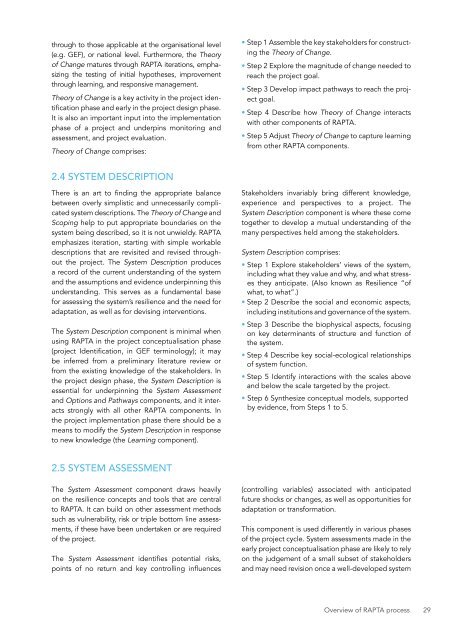DESIGNING PROJECTS IN A RAPIDLY CHANGING WORLD
srun3013fp1
srun3013fp1
Create successful ePaper yourself
Turn your PDF publications into a flip-book with our unique Google optimized e-Paper software.
through to those applicable at the organisational level<br />
(e.g. GEF), or national level. Furthermore, the Theory<br />
of Change matures through RAPTA iterations, emphasizing<br />
the testing of initial hypotheses, improvement<br />
through learning, and responsive management.<br />
Theory of Change is a key activity in the project identification<br />
phase and early in the project design phase.<br />
It is also an important input into the implementation<br />
phase of a project and underpins monitoring and<br />
assessment, and project evaluation.<br />
Theory of Change comprises:<br />
• Step 1 Assemble the key stakeholders for constructing<br />
the Theory of Change.<br />
• Step 2 Explore the magnitude of change needed to<br />
reach the project goal.<br />
• Step 3 Develop impact pathways to reach the project<br />
goal.<br />
• Step 4 Describe how Theory of Change interacts<br />
with other components of RAPTA.<br />
• Step 5 Adjust Theory of Change to capture learning<br />
from other RAPTA components.<br />
2.4 SYSTEM DESCRIPTION<br />
There is an art to finding the appropriate balance<br />
between overly simplistic and unnecessarily complicated<br />
system descriptions. The Theory of Change and<br />
Scoping help to put appropriate boundaries on the<br />
system being described, so it is not unwieldy. RAPTA<br />
emphasizes iteration, starting with simple workable<br />
descriptions that are revisited and revised throughout<br />
the project. The System Description produces<br />
a record of the current understanding of the system<br />
and the assumptions and evidence underpinning this<br />
understanding. This serves as a fundamental base<br />
for assessing the system’s resilience and the need for<br />
adaptation, as well as for devising interventions.<br />
The System Description component is minimal when<br />
using RAPTA in the project conceptualisation phase<br />
(project Identification, in GEF terminology); it may<br />
be inferred from a preliminary literature review or<br />
from the existing knowledge of the stakeholders. In<br />
the project design phase, the System Description is<br />
essential for underpinning the System Assessment<br />
and Options and Pathways components, and it interacts<br />
strongly with all other RAPTA components. In<br />
the project implementation phase there should be a<br />
means to modify the System Description in response<br />
to new knowledge (the Learning component).<br />
Stakeholders invariably bring different knowledge,<br />
experience and perspectives to a project. The<br />
System Description component is where these come<br />
together to develop a mutual understanding of the<br />
many perspectives held among the stakeholders.<br />
System Description comprises:<br />
• Step 1 Explore stakeholders’ views of the system,<br />
including what they value and why, and what stresses<br />
they anticipate. (Also known as Resilience “of<br />
what, to what”.)<br />
• Step 2 Describe the social and economic aspects,<br />
including institutions and governance of the system.<br />
• Step 3 Describe the biophysical aspects, focusing<br />
on key determinants of structure and function of<br />
the system.<br />
• Step 4 Describe key social-ecological relationships<br />
of system function.<br />
• Step 5 Identify interactions with the scales above<br />
and below the scale targeted by the project.<br />
• Step 6 Synthesize conceptual models, supported<br />
by evidence, from Steps 1 to 5.<br />
2.5 SYSTEM ASSESSMENT<br />
The System Assessment component draws heavily<br />
on the resilience concepts and tools that are central<br />
to RAPTA. It can build on other assessment methods<br />
such as vulnerability, risk or triple bottom line assessments,<br />
if these have been undertaken or are required<br />
of the project.<br />
The System Assessment identifies potential risks,<br />
points of no return and key controlling influences<br />
(controlling variables) associated with anticipated<br />
future shocks or changes, as well as opportunities for<br />
adaptation or transformation.<br />
This component is used differently in various phases<br />
of the project cycle. System assessments made in the<br />
early project conceptualisation phase are likely to rely<br />
on the judgement of a small subset of stakeholders<br />
and may need revision once a well-developed system<br />
Overview of RAPTA process 29


